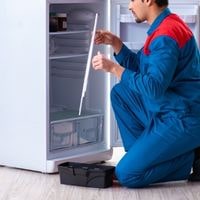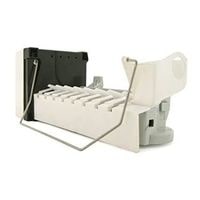Sub zero ice maker not working. You won’t need to worry about running out of ice anymore when you use a Sub-Zero refrigerator. One advantage to owning a Sub-Zero refrigerator is that it comes with an automatic ice maker.
Being able to switch an appliance on and walk away makes your life much easier, but there are instances where this convenience can be the subject of issues that will cause you to trip up while producing ice.
It’s frustrating when an automatic ice maker doesn’t work. Here are some DIY troubleshooting tips when your Sub-Zero ice maker freezes over and stops working altogether.
Sub zero ice maker not working
The one downside to having an automatic ice maker in your Sub-Zero refrigerator is that it could stop making ice.
Common problems include a faulty thermometer or a temperature setting that’s too high, turning off the ice maker as a safety precaution. Try these DIY troubleshooting tips to get your refrigerator back up and running.
The water inlet valve should be replaced
The water inlet valve is made possible by having a functional electrical current. Another aspect that the water inlet valve requires to operate is the required pressure, which needs to be at least 20 psi.
If any part of this system malfunctions, the ice maker will not work as it should and will replenish with clean, clear ice cubes. If the water inlet valve has too little or insufficient pressure, it will not function properly, and you might have to replace it eventually.
But before that happens, make sure an electrician checks if the electrical current is there by using a multimeter. If so, and everything seems fine, remember that there are different models of water inlet valves. Consult their manual to identify them and make sure you order the right one.
A clogged water filter
A clogged water filter can restrict the flow of water to the dispenser and prevent the ice maker from being able to work properly.
By replacing the water filter at least every six months, one can regain a proper flow of clean water and will ensure that there is no impurity when brewing coffee or making ice cubes.
The temperature in the freezer is too high
If the freezer temperature is above 10 degrees Fahrenheit (-12C), the ice maker will not produce ice cubes efficiently. The freezer temperature should be set between 0 and 5 degrees (-18 to -15) for the ice maker to work properly.
If the freezer temperature gets too high, ensure that the condenser coils are clear of debris and check that the condenser fan is working properly as well.
Also, be sure that frost/fog isn’t building up on any internal components or coils within your machines such as those located on the evaporator and condenser coils. If this is happening, you might have some problems with your system’s defrost mechanism failing to do its job correctly.
Replace the ice maker assembly
One component of the ice maker assembly is defective, having gone out on you much sooner than it was slated to.
Due to many factors that would have no bearing on this situation, like age and prior use, a replacement will not be made available for purchase individually.
Therefore, we are going to need you to purchase the entire set of replacement pieces together as a bundle so that you don’t have any issues down the road with your appliance and its ice usage capabilities.
The door switch is defective
The refrigerator door has a switch that registers when the door is opened or closed. This is used to both turn off the ice dispenser and water dispense as well as illuminate the inside lights on the refrigerator.
If this switch were to fail, you would no longer be able to open or close your refrigerator door and thus would not have access to any of these features, including freezer functions, ice, or filtered water.
In order to determine if this switch is defective, all you need to do is use a multimeter ( ohmmeter ) between the two metal prongs that protrude from it on either side. If there are no ohms between the two prongs, then it likely needs to be replaced.
There is no continuity in the icemaker switch
The ice cube maker switch might be broken. It’s also possible that the switch got turned off by accident. Check to see if the switch is turned on and if so, then see if your ice maker is producing any cubes at all.
If the ice maker is not producing any cubes whatsoever, use a multimeter to test for continuity and see if the ICEMAKER SWITCH has continuity. If there is continuity, then you should replace the ICEMAKER SWITCH because it’s definitely faulty.
Faulty Ice Level Control Board
Some refrigerators have ice buckets with an infrared beam attached to them. When the ice in the bucket reaches the top of it, the infrared beam is broken and that’s when your fridge will shut off the ice maker.
If there isn’t enough ice in your bucket and you need some more, the ice level control board sends a signal that causes the refrigerator to burn more electricity to heat up the ice bucket until it refreezes.
If the ice level control board isn’t getting any power, see if your purifier is plugged into a live outlet if not get another one cause something is wrong with one or both of them. Otherwise, check all of your fuses for any blown ones before replacing anything else because if there are no blown fuses then replace your ice level control board.
Defective Icemaker Module
An icemaker is a great appliance for dispensing ice from a tray or bucket. The icemaker takes water from your refrigerator and then freezes it into solid cubes.
The temperature of the freezer compartment helps keep the water at an optimal level for freezing. When flavorings are added to the water, you get flavored ice.
Depending on your model, your icemaker uses either motor-driven ejector blades or paddles to release the frozen blocks or action of gravity in a tray system to dispense them.
Once they’re ready, you can use them for drinks and other cold treats. If your ice maker is not working as intended, first figure out what’s wrong with it by consulting with a professional who will be able to tell you if there are any loose connections in the wiring that control it. This will entail checking all fuses and relays inside too.
Related Guides
